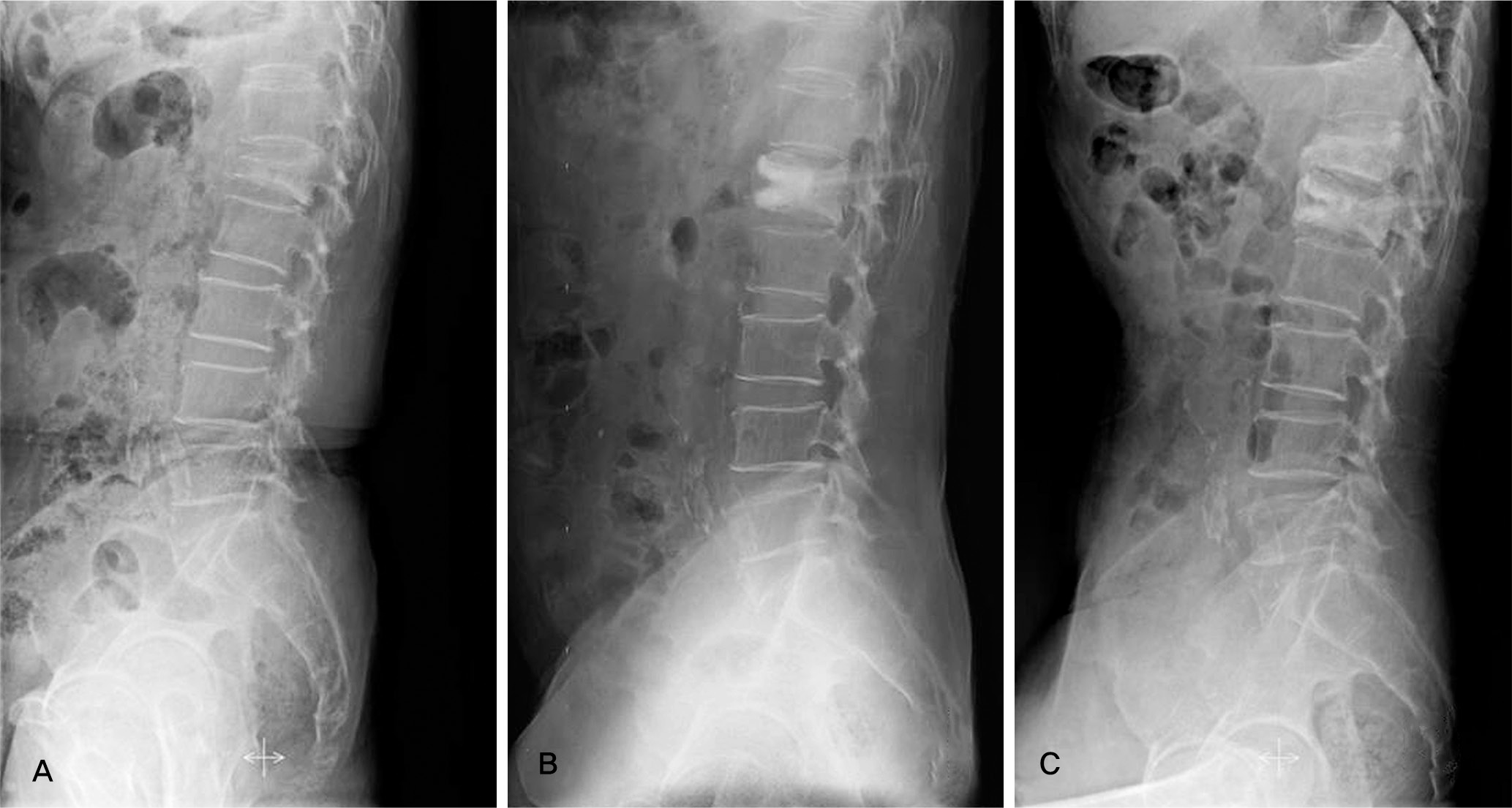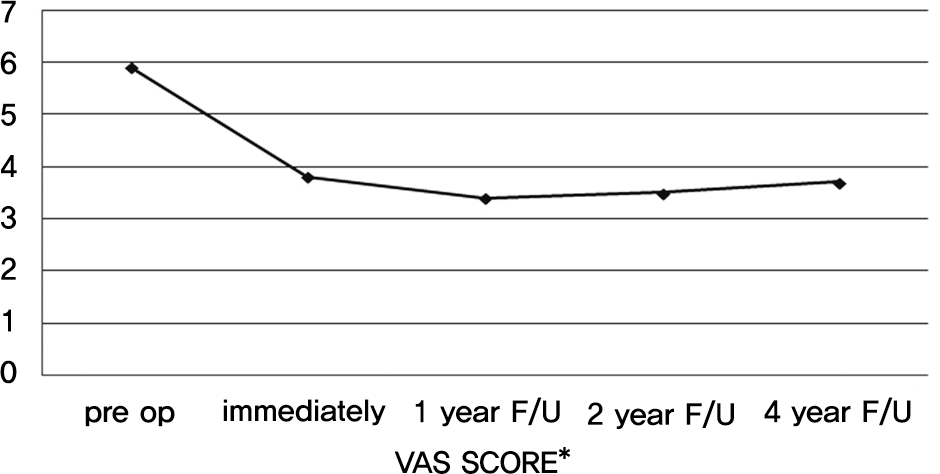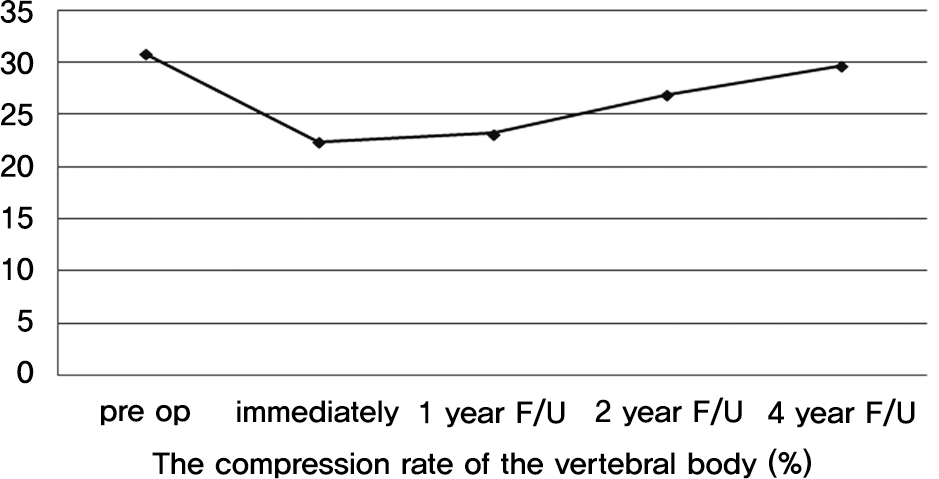Abstract
Objectives
The purpose of this study was to assess the clinical efficacy and long term results of patients undergoing percutaneous vertebroplasty, with bone cement, for osteoporotic compression fractures.
Summary of Literature Review
Percutaneous vertebroplasty is an effective surgical method for the treatment of osteoporotic compression fracture.
Materials and Methods
Among 82 patients who underwent percutaneous vertebroplasty, with bone cement, between February 2005 and February 2008, 54 patients who were followed-up for more than 4 years were selected. We compared the postoperative clinical and radiological findings immediately and at 1, 2, and 4 year followup. Clinical findings were evaluated using the Visual analogue scale (VAS) score. Radiologically, height of the vertebral body and adjacent vertebral body fracture were also assessed.
Results
Clinical outcome by mean VAS score revealed a change from 5.9 to 3.8 points preoperatively. The mean VAS scores were 3.4, 3.5 and 3.7 at 1, 2, 4 year followup, retrospectively. The compression rate of the vertebral body on plain radiographs was 30.8% preoperatively, 22.4% immediately after the operation, 23.2% at 1 year followup, 26.9% at 2 year followup, and 29.7% at 4 year followup. A new adjacent vertebral body fracture was noted in 7 patients at 1 year followup and 3 patients at 2 and 4 year followup, respectively.
Conclusions
Percutaneous vertebroplasty is a valuable method for the treatment of osteoporotic compression fractures, providing immediate pain relief as well as long term pain relief. However, percutaneous vertebroplasty gave unsatisfactory report about height of the vertebral body and adjacent vertebral body fracture.
Go to : 
REFERENCES
1. Galibert P, Deramond H, Rosat P, Le Gars D. Preliminary note on the treatment of vertebral angioma by percutaneous acrylic vertebroplasty. Neurochirurgie. 1987; 33:166–8.
2. Barr JD, Barr MS, Lemley TJ, Mccann RM. Percutaneous vertebroplasty for pain relief and spinal stablization. Spine (Phila Pa 1976). 2000; 25:923–8.
3. Deramond H, Depreister C, Galibert P, Le Gars D. Percutaneous vertebroplasty with polymethylmethacrylate; technique, indication, and results. Radiologic Clinics of North America. 1998; 36:533–46.
4. Weill A, Chiras J, Simon JM, Rose M, Sola-Martinez T, Enkaoua E. Spinal metastasis: indications for and results of percutaneous injection of acrylic surgical cement. Radiology. 1996; 199:241–7.
5. Lindsay R, Burge RT, Strauss DM. One year outcomes and costs following a vertebral fracture. Osteoporos Int. 2005; 16:78–85.

6. Perez-Higueras A, Alvarez L, Rossi RE, Quinones D, AlAssir I. Percutaneous vertebroplasty: longterm clinical and radiological outcome. Neroradiology. 2002; 44:950–4.
7. Rockwood CA, Green DP, Bucholz RW. Rockwood and Green's fractures in adults. Vol. 3. 6th ed.Philadelphia, PA: Lippincott Williams & Wilkins;2006. p. 4–11.
8. Tsai TT, Chen WJ, Lai PL, et al. Polymethylmethacrylate cement dislodgement following percutaneous vertebroplasty: a case report. Spine (Phila Pa 1976). 2003; 28:457–60.
9. Heo DH, Chin DK, Yoon YS, Kuh SU. Recollapse of previous vertebral compression fracture after percutaneous vertebroplasty. Osteoporos Int. 2009; 20:473–80.

10. Kim WJ, Yeom JS, Kang JW, et al. Percutaneous vertebroplasty: short-term results of 38cases. J Korean Orthop Assoc. 2002; 37:471–7.
11. Teng MM, Wei CJ, Wei LC. Kyphosis correction and height restoration effects of percutaneous vertebroplasty. AJNR Am J Neuroradiol. 2003; 24:1893–900.
12. Mousavi P, Roth S, Finkelstein J, Cheung G, Whyne C. Volumetric quantification of cement leakage following percutaneous vertebroplasty in metastatic and osteoporotic vertebrae. Neurosurg. 2003; 99:56–9.

13. Shin KS, Kim JS, Lee DW. Surgical treatment of root injury after percutaneous vertebroplasty: case report. J Korean soc spine surg. 2002; 9:54–8.

14. Chiras J, Depriester C, Weill A, Sola-Martinez MT, Deramond H. Percutaneous vertebral surgery. Technics and indications. Neuroradiol. 1997; 24:45–59.
15. Cortet B, Cotten A, Boutry N, et al. Percutaneous vertebroplasty in patients with osteolytic metastases or multiple myeloma. Rev Rhum Engl Ed. 1997; 64:177–83.
16. Yeom JS, Kim WJ, Choy WS, Lee CK, Chang BS, Kang JW. Leakage of cement in percutaneous transpedicular vertebroplasty for painful osteoporotic compression fractures. J Bone Joint Surg. 2003; 85:83–9.

17. Jensen ME, Avery JE, Mathis JM, Kallmess DF, Cloft HJ, Dio JE. Percutaneous polymethylmethacrylate vertebroplasty in the treatment of osteoporotic vertebral body compression fracture: technical aspects. Am J Neuroradiol. 1997; 18:1897–904.
Go to : 
 | Fig. 1.Simple lateral radiographs of 75 year-old female with L1 compression fracture. (A) Preoperative radiograph showed L1 compression fracture. (B) Postoperative radiograph showed percutaneous vertebroplasty on L1. (C) Postoperative 1 year follow up radiograph showed collapse of adjacent vertebra. |
 | Fig. 4.Simple lateral radiographs of 76 year-old female with L2 compression fracture. (A) Preoperative radiograph showed L2 compression fracture. (B) Postoperative radiograph showed percutaneous vertebroplasty on L2. (C) Postoperative 1 year follow up radiograph showed recollapse of cement injected vertebra. |




 PDF
PDF ePub
ePub Citation
Citation Print
Print




 XML Download
XML Download